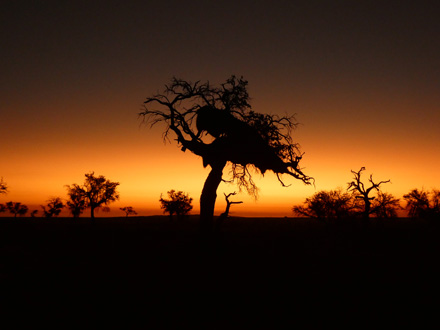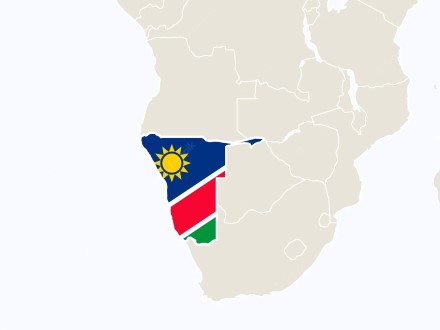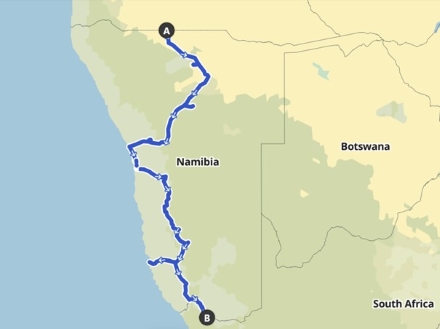
Oshikango – Etosha NP … Otjiwarongo – Omaruru – Karibib – Spitzkoppe – Henties Bay – Swakopmund – Solitaire – Sesriem – Helmeringshausen – Aus – Luderitz … Aus – Rosh Pinah – Aussenkehr – Noordoewer
August 18th, 2022 – Oct 3, 2022
1741 km cycled
Watch the video!
Namibia was what Darina had been looking forward to most on this trip. The desert landscapes and red dunes were the big draw. With a landmass 1.5 times the size of France and a population of 2.5 million (similar to Paris!), it was clear we would not have towns every few kms. The population density of Namibia averages at 3 people per square km, as opposed to Switzerland’s 219! This would make it tough. However, with English as the national language and traffic on the left-hand side, Darina would feel somewhat at home. Kurt, having done his research (as usual!), knew that Namibia would be one of the hardest countries to cycle, but also one of the most scenic. At the tender age of 64, he was still up for the challenge!
Crossing the border to Namibia was a shock to the system. Ferocious head wind coupled with aggressive driving styles on a road with no hard shoulder accentuated our nostalgic memories of Angolan truck drivers. We were assured that this was related to payday and weekend traffic. The northern part of Namibia is the busiest. In villages with 10 to 12 houses, pretty much every house had a name be it shebeen, bar, betting office or shop.
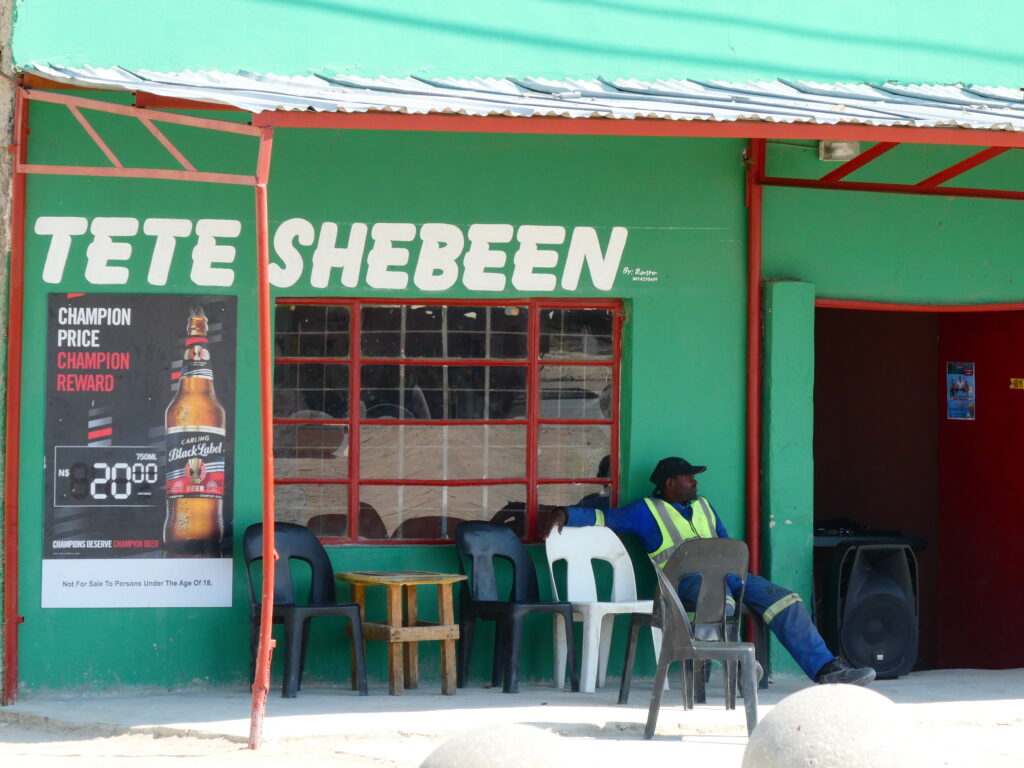

As the road signs became more exotic and fences marked territory, we wondered about wild camping. The police advised against it, more because of the possible threat posed by two-legged friends rather than that of wild animals. We were therefore very happy when the police themselves or local families allowed us camp next to their dwellings.


When Monday came round, the road was a great deal quieter, but we had other plans … like checking out the magnificent Etosha National Park! 
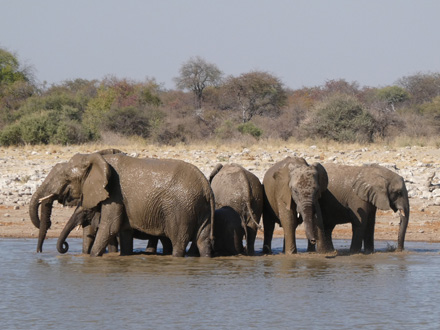

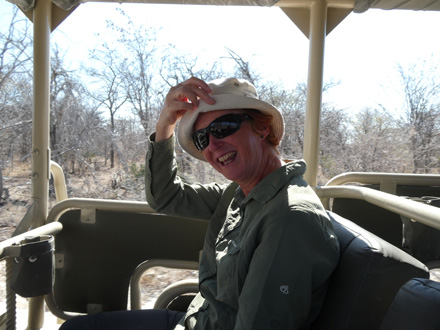
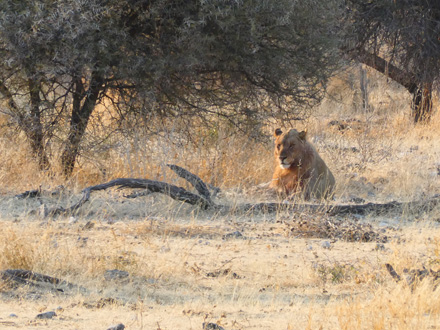
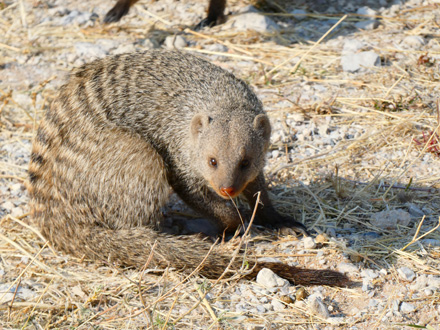
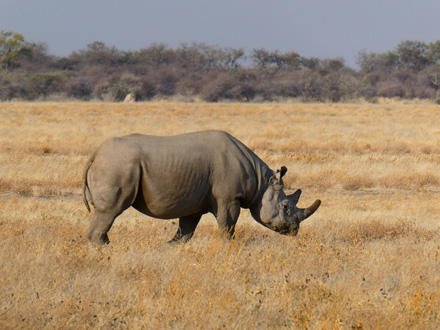
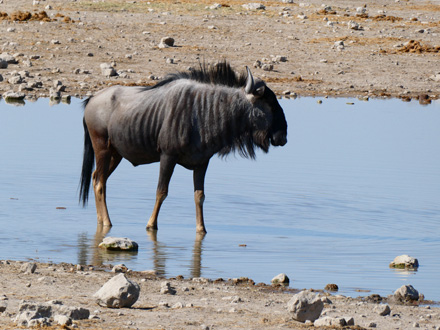
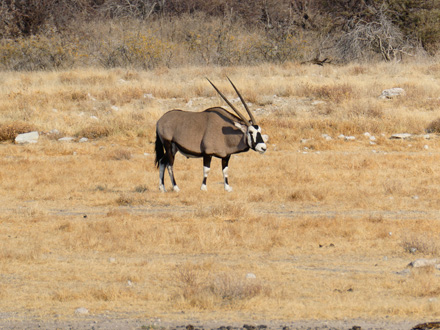
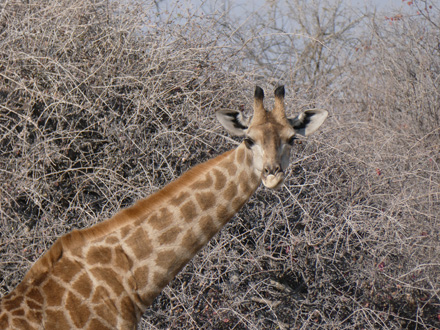
At Etosha, we bumped into Silvia and Linda from Cicliste Per Caso
who, with the help of their photographer Pietro (@pietro_suglia_ph), were making a documentary about cycling in Namibia. They warned us of the sand and gravel ahead, which at that point sounded a whole lot more enticing that being killed by a truck on the main road! So, we were delighted with their lift to Otjiwarongo to visit the Cheetah Conservation Fund.


Time is of the essence when it comes to preventing the extinction of the world’s fastest land mammal. The Cheetah Conservation Fund in Namibia is on the case rescuing captured/injured cheetahs, supplying lifestock guarding dogs and educating farmers and children about these fascinating animals. However, with just 10,000 cheetahs left worldwide, trojan work is required if the cheetah’s destiny is not to be gone with the wind…
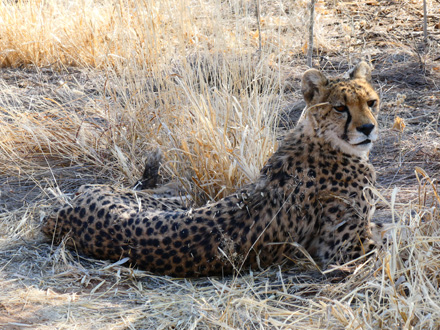
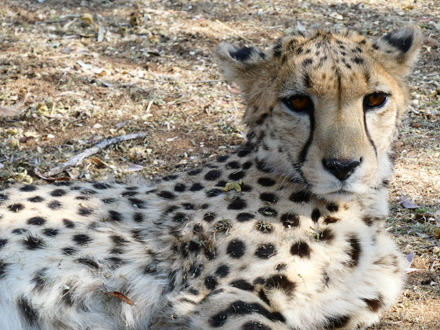
Since our arrival in Africa, part of our daily routine is checking our tyres for thorns. After a picnic or bush camp, or when blown off the road by a racing lorry driver (!), we often find these acacia thorns cosily attached to our tyres. These bushes account for up to 14% of the land in Namibia and beyond the grief they give cyclists, the encroaching bush is reducing the savannah habitat of cheetahs and is contributing to desertification.
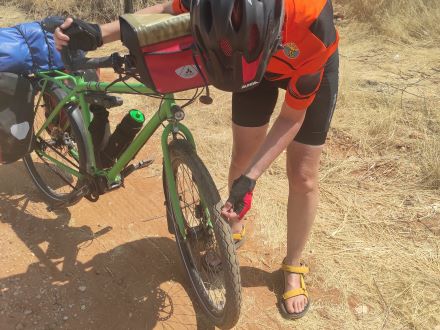

The Cheetah Conservation Fund has come up with an ingenious solution to the problem: the production of solid fuel wood blocks from these acacia thorn bushes. These “bushbloks” burn as hot as coal, produce very little ash and are classified as smokeless fuel. We tried them out at our camp near the Cheetah Conservation Fund (grazie @linda_ronz 😀) and were mega impressed with the result. Three cheers for this fabulous project!
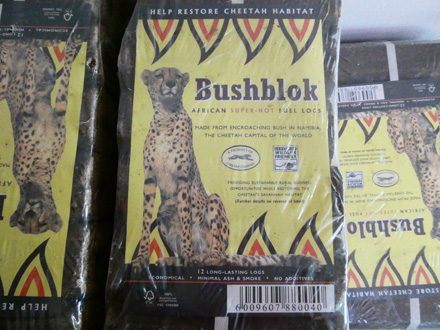

When it comes to roads in Namibia, cyclists have two choices. Risk being blown off the main road by speeding truck drivers or trudge along in sand and corrugations on the minor ones. Take your pick! We did make one amazing discovery: the C33 from Otjiwarongo to Karibib: quiet and tarred with exceptionally accommodating truck drivers 🙂 It’s a puzzle as to why we are both smiling in the pictures below!


The granite heads of Spitzkoppe are a sight to behold. Magically changing colour with the angle of the sun, these magnificent outcrops, dating back 120 million years, offer dream campsites under a starlit sky second to none. Certainly worth every bead of sweat and frustrated curse generated by the strenuous access sand track!

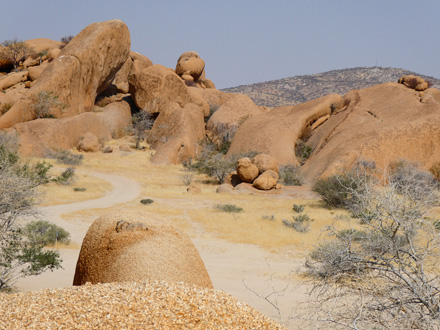

Spitzkoppe is a campers’ absolute dream. Tents can be placed in the shelter of the granite heads and as the sun goes down the gecko symphony begins and you can nurse your pyromania instincts.


Following the D1918 dirt road to Henties Bay, we passed through Dorob NP, where we had our choice of camping spots, but not as much as a bush to hide behind. It was one of our coldest nights in Namibia – we had every item of clothing we possessed on us in the sleeping bags that night: Thermals, fleeces, padded jackets – the works. And this is Africa!

Referred to by early Portuguese explorers as the “Gates of Hell”, Namibia’s Skeleton Coast has caused many to meet their doom over the centuries. Shipwrecks still dot the rough coastal waters and the meeting of the cold Benguelan Current and the hot Namib desert air causes dense coastal fog year-round.

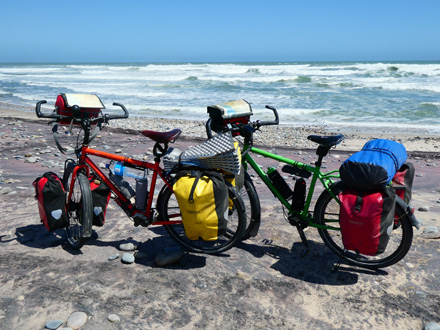
Today, colonial houses and place names are reminiscent of the German colonial presence from 1892 until 1915.


Flamingoes abound and we were lucky enough to witness spectacular sunsets! While the road surface is an absolute delight, the southwest winds slowed us down to a 7kmph crawl!
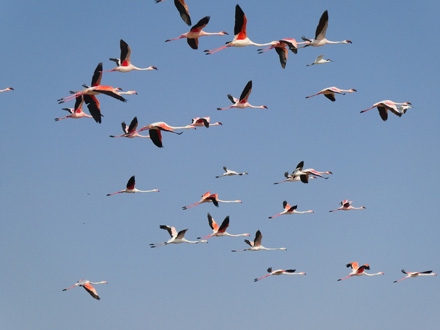
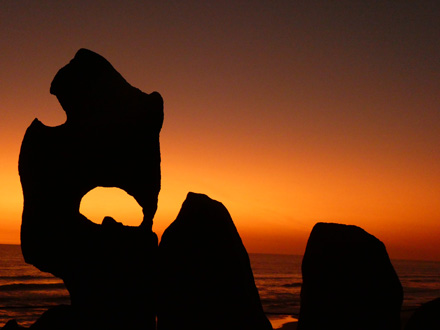
Food for a week! This is what our shopping looked like leaving Swakopmund on our 350km desert route through the Naukluft Mountains to Sesriem. With absolutely nothing until Solitaire at 265km, which would probably just offer a few crackers and cans, we were determined to keep the culinary standards high all the way. Water would be the challenge. Our starter pack of 12.5 litres would probably only suffice for two days and then we would be dependent on the goodwill of passers-by.

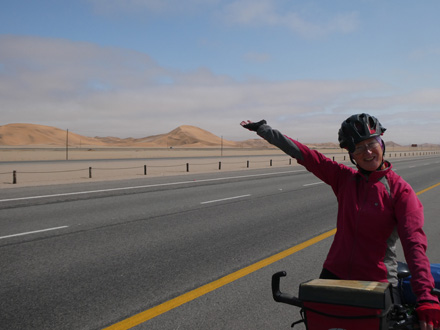
Well, we can happily report that we were overwhelmed by the generosity of fellow travellers (in jeeps and buses) who showered us with fresh fruit, soft drinks, waffles, energy bars, quick dinners and litres and litres of ice-cold water, as we rattled along on the gravel/sand track. Proper kiosks on wheels! A huge thanks to each and every one of you!


A week of African massage! Sounds fabulous right? Well, this special spa treatment is exactly what’s in store when you take the C14 followed by the C19 to Sesriem! Soon after leaving the Skeleton Coast the day spa welcome sign appears and that lovely firm salted surface gives way to sand and gravel with enough corrugations to rattle every bone of your body from sunrise to sunset.
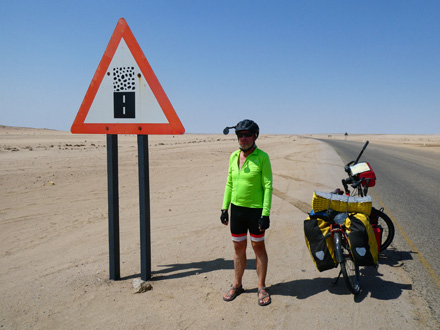

Of course, there will be breaks when you’ll be walking your bike and chatting tourists, who will confirm any doubts that you may have had with regard to having lost your sanity 😝





We were hanging out for our rest day in Solitaire. This service station and bakery was set up by Moose McGregor (RIP), a Scot, who came out to these parts looking for peace. Bet he found it here 😉 Well, it was a welcome break from the corrugations. And, of course, we had to try the apple pie the place is famous for. The Solitaire Country Lodge had a special rate for cyclists in their lovely campground, where Kurt made good use of the pool to find the puncture in his Exped mat.

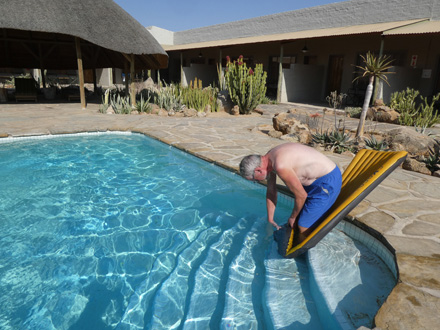
What we hadn’t planned on was a sand storm. After the first night camping at Solitaire, we had sand in our eyes, ears, noses and even between our teeth! Our inner tent had that real beach feel. And the wind continued. Marion, at the Solitaire Lodge was adamant that we would have shelter for the second night and organised a free upgrade for us to one of their luxury rooms. What a service! Namibian hospitality at it’s best.

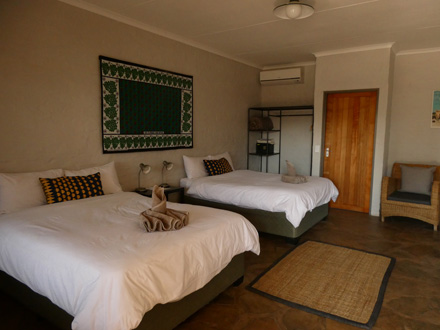
There was some method in our madness. The gravel road we rattled along for a week led to Sossusflei (Dead-end marsh). This salt and mud pan surrounded by huge orange-coloured dunes is probably Namibia’s most photographed attraction. Climbing Dunes 45 as well as Big Daddy is part of the programme, before wandering around Deadvlei, where the dunes have diverted the river causing the numerous camel thorn trees in the marsh to die. Now, as cyclists, we have to admit that these camel thorn trees are those we have most admired so far in Africa – not a thorn in sight!
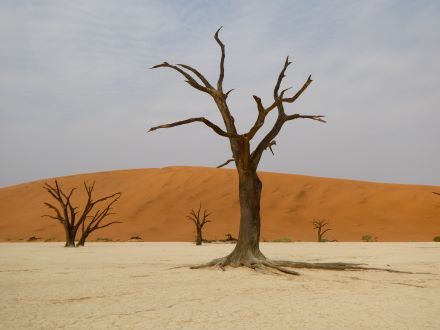

By then, we’d reached the wall! The novelty of gravel roads, sand tracks and expedition-style packing was wearing thin. Kurt was craving tar roads, and the next bus that would shuttle us out to the main road wasn’t for another three days. But then, as luck would have it, we bumped into Phlip, a local 70-year-old beef and sheep farmer clad in full lycra cycling gear. With his wife Marietjie and his son Phil (Unbounded Namibia), they were guiding a group of South African cyclists from Sossusflei south to the Orange River on the remote, but beautiful C27 & C13 gravel roads. His invitation to join the group as far as a tar road, with support vehicles to carry our luggage and meals provided, was one we just couldn’t turn down.



What followed was four thoroughly enjoyable days cycling with a lively bunch of very welcoming and capable off-road cyclists, who avoid tar roads like the plague! With no luggage and less air in our tyres, it was a whole new experience for us. Add meals, snack breaks and official campgrounds and we hardly knew ourselves. The road quality was a whole lot better than what we’d had on the C14, which is renowned as the “worst road in the country!” and the scenery was quite special. A big thanks to the whole group for adopting us as far as the tar road in Aus.



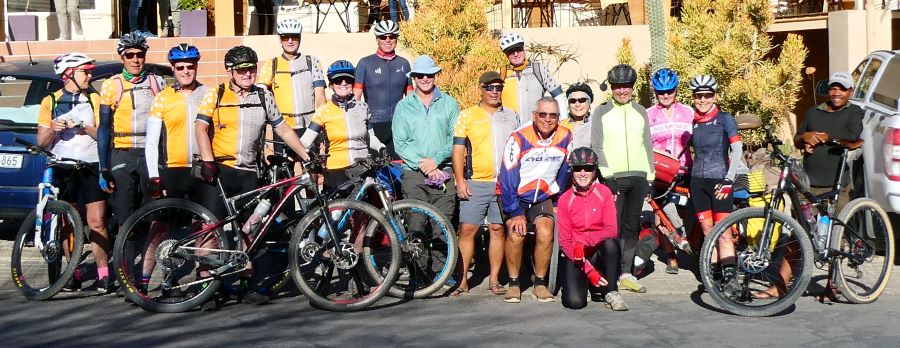
On arriving in the village of Aus, there was some sad news waiting for us. As the last grains of Big Daddy still clung to the soles of our feet at Sesriem, Darina’s Daddy passed away peacefully in his sleep. In his own bed, in the house where he lived his whole life, on the farm he called home. It was just as he would have wished. The internet was down that morning when we rattled out of Sesriem, and as we entered the mountains, the thunder rolled, and the rain came down. A mist you wouldn’t mind being out in. Ireland was calling, but that dreaded message had to do the rounds of cyberspace for four days until we had coverage again. An eight-hour car ride and a fifteen-hour flight separated us from Dublin. It wasn’t to be. The funeral would have to go ahead without us.
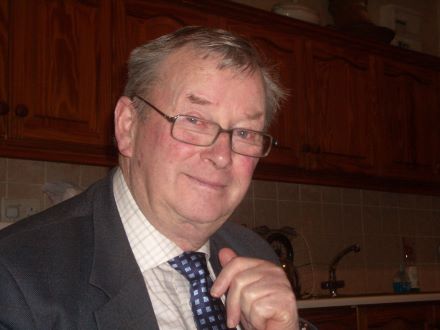
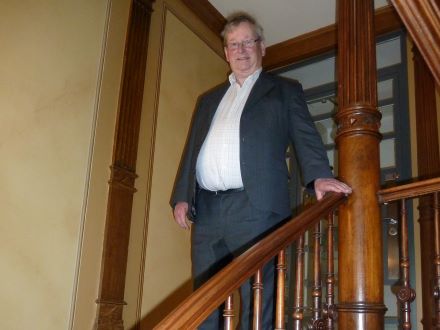

A great man for funerals, one of Daddy’s catch phrases was “You’ll never guess who’s after dying!” Well at the tender age of 88, it should be no great surprise when your time is up. And travelling in the second least populated country in the world, it should also be no great surprise if the internet coverage doesn’t extend to every remote corner of the country. In the 90s, we were dependent on post restante, picking up old news arriving by snail mail to general post offices around Asia. On our last big trip in Latin America, we relied on questionable connections in internet cafes, every ten days or so. This time with a mobile in our pockets, we were as connected as we could be. And yet, life (and death) went on without us. That’s what travel is all about. That’s the risk you take. And that’s what Daddy never hindered or discouraged and what I (Darina) am eternally grateful for.
Fortunately, we were able to join the funeral livestream and feel part of Daddy’s big send-off. A big shout out to all in Aus Bahnhof Hotel who made this possible and to the amazing cycling group who supported us dearly at this difficult time. Daddy, may you rest in peace.

There is no place like Namibia with its wide-open spaces and barren landscapes to process grief, and our ride down to Lüderitz was no exception. We even completed the longest distance of our trip so far: 127km in one day. This former German colony on the coast has somewhat more charm than Swakopmund further north, but its history is horrifying. Up to 3,000 local Africans are thought to have died in the early 1900s as a result of forced labour in the concentration camp on Shark Island.



When diamonds were discovered in 1909 in Kolmanskop nearby, the place flourished and some 350 Germans immigrated to make their fortunes. They lived in style. There was a butcher, baker, hospital, school and even a bowling alley and opera house for entertainment. When the diamonds started to peter out and more appeared further south, the locals moved out. Today, it’s a ghost town with the sand we know so well taking over and creating a photographer’s paradise.
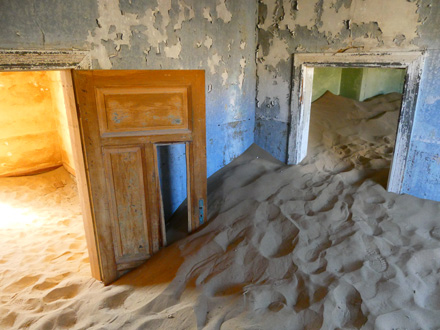
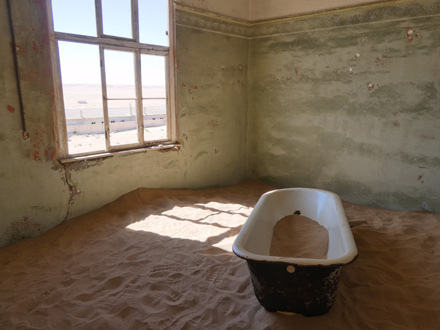
Rather than climb the 127km back up to Aus, we jumped on a bus and recommenced our cycle again from there, following the beautifully quiet C13 road to Rosh Pinah. Because the zinc from the local mine is transported by road to Lüderitz, the road is tarred and a lovely one to ride. Actually, mining accounts for 25% of Namibia’s income.
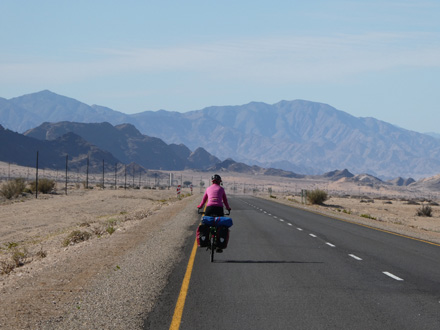

From there we continued down to the Orange River, which forms the border with South Africa. What a sight! These two days cycling through the magnificent gorge created by one of Namibia’s greatest rivers was the icing on the cake. Afer so much arid desert, it was a dream to suddenly have green on the colour palatte.

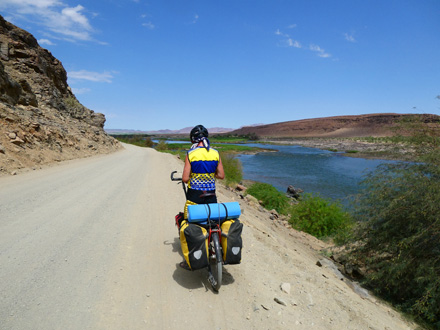

Dozens of baboons, monkeys and rock hyraxes complete this exotic picture. Incidentally, these rock hyraxes are what were on sale as jerky meat on the side of the road in Angola.


And before we knew it, we were back on a tar road with vineyards as far as the eye could see: table grapes thanks to irrigation from the Orange River. What was more of an eye-opener was the shanty town housing the grape pickers from all corners of the country. Unlike in Europe, those we spoke to were happy enough with the deal and felt it was better than “sitting at home doing nothing”.


Namibia is quite the draw for touring cyclists, and we were lucky to meet up with a few en route. Gerhard (Austria) based in Kenya has been cycing the continent these past four years. Hans Albert (The Netherlands) also started his African trip in Angola and is south bound like us at the moment. Gulnara (Russia) and Dimitri (France) are on a mission to circumnavigate the globe by human power only. From Cape Town it will be a three-month paddle across the Atlantic Ocean to Brazil!



The menu was generally meat dominated with quite a few game options like oryx and springbok steaks, as well as kudu stew. Portions were generous, and fries or mashed potatoes accompanied most dishes. Hake was the standard fish available and, on the coast, there were more seafood choices. Main courses ranged in price from 80-200 Namibian Dollara (5-12 Euros). Darina felt quite at home with the Namibian fry-up for breakfast and Kurt is a big fan of malva pudding (a moist baked sponge with custard) for dessert! Darina enjoyed the local Stoney Ginger Beer while Kurt lived on Windhoek Draft!
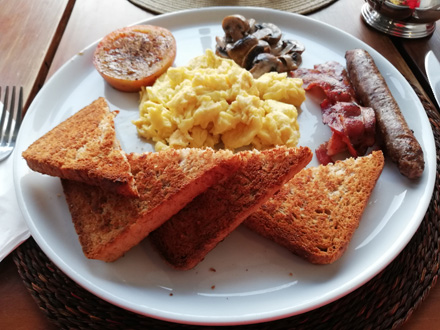
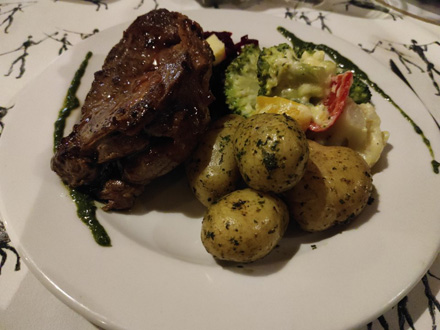
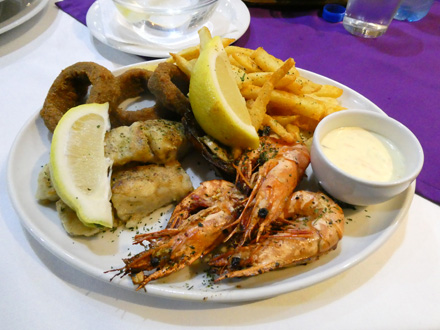
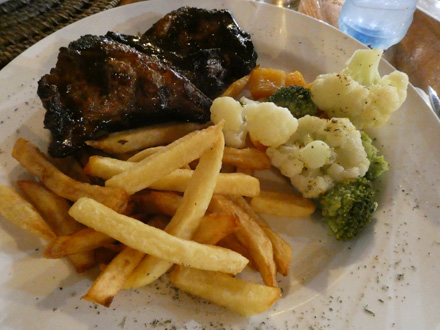
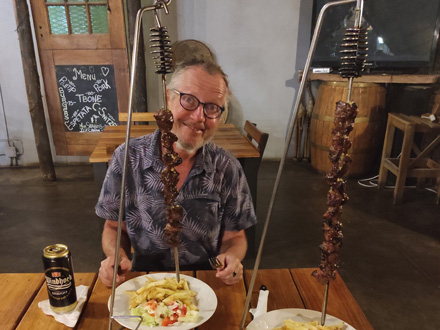


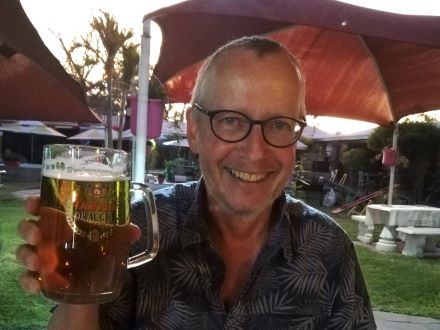
Campgrounds cost between 100 and 200 Namibian dollars (6-12 Euros) per person, and you could get a room for anything from 400 Namibian dollars (30 Euros) up. In both cases, you often had your own private bathroom as part of the deal! What is also really special is the fact that it is possible to camp in exclusive resorts with full access to the pool and facilities.
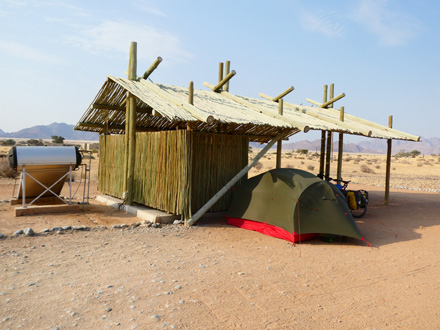

Namibians have a proper tourist industry happening and they know how to do things in style. They are extremely proud of true Namibian hospitality and would give the Irish and their céad mile fáilte a run for their money. Norotshama River Resort on the Orange River is a prime example and it was the perfect place to spend our last few days in Namibia 🙂


As a cycling destination, while Namibia is certainly not the easiest, it has definitely been one of our more stunning rides. Main roads are busy and minor roads are often unpaved, corrugated sand tracks. However, the spectacular scenic rewards on such minor roads justify the extra effort.
Namibia is a place where you have to be kind to yourself. Expedition-style luggage can wear your out and so rest days and a little pampering in between is the way to go. And as we learned from Phlip, when the head is stronger than the pain, you can achieve anything! 😉

